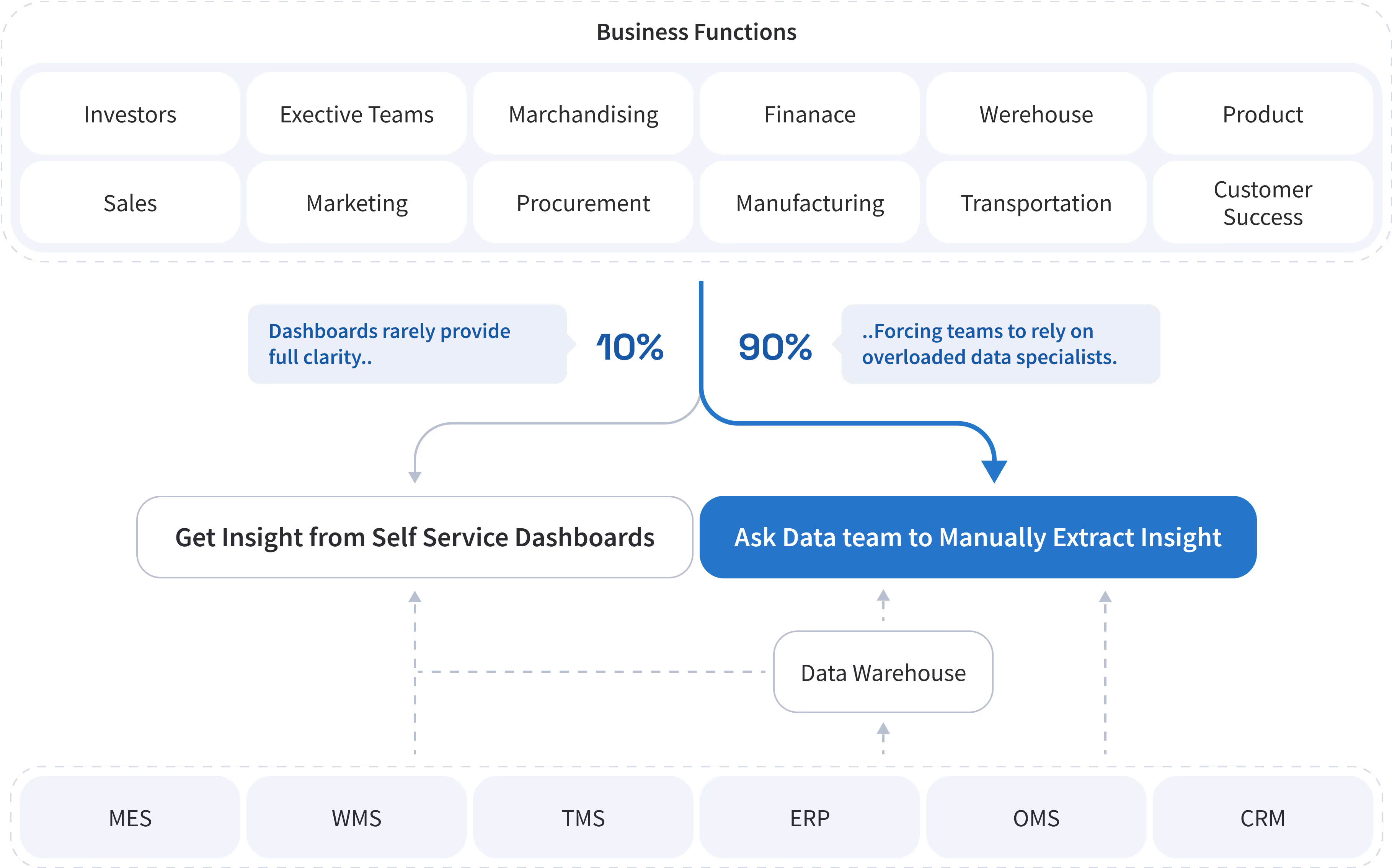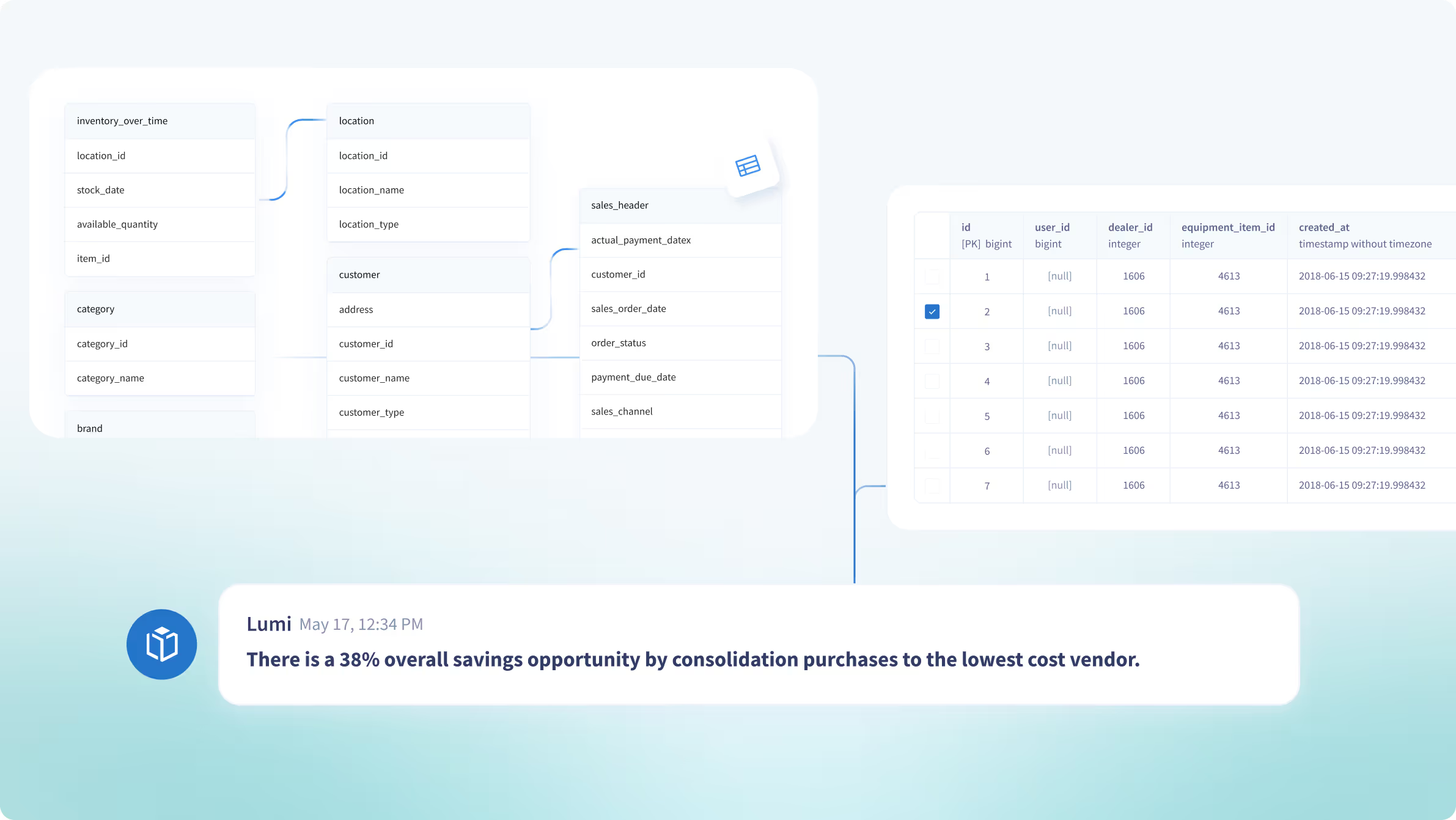Back to blog
Back to Case Studies
Semantic Layers and Data Democratization
.avif)


The blog addresses the data bottleneck issue faced by non-technical business users, leading to delayed decision-making due to overburdened data teams. The solution lies in semantic parsing, an AI technology that translates everyday language into data queries.
Breaking down the Data Bottleneck through Semantic Layers and Data Democratization
In the age of digital acceleration, businesses across sectors have recognized the transformative potential of data analytics. The promise of machine learning to redefine business functions, optimize revenue streams, and streamline cost structures has become an irresistible draw, especially for industries sitting on vast amounts of dormant data, such as Consumer Products, Retail, and Supply Chain. Semantic layers enable this promise by simplifying enterprise data complexity and making it possible to be provided as context to AI agents. This approach democratizes analytics, empowering users across all levels to make informed decisions without deep technical expertise.
What is Data Democratization?
Data democratization is the process of making data accessible, understandable, and actionable for a broader audience within an organization. It eliminates the reliance on technical experts and empowers non-technical users to independently derive insights and make informed decisions.
How Data Democratization Empowers Businesses
- Self-Service Analytics: Non-technical employees gain the ability to perform analyses and generate insights without relying on IT teams.
- Improved Collaboration: Teams across departments access consistent data, driving innovation and informed decision-making.
- Enhanced Productivity: Employees can focus on strategic initiatives instead of waiting for data approvals or transformations.
To realize the benefits of data democratization, organizations must simplify complex data structures—a challenge addressed through the use of semantic layers.
What Are Semantic Layers?
Semantic layers are a metadata-driven framework that converts often obscure, complex data fields into human-readable formats that both people and AI systems can easily understand. This translation enables AI models to understand what the field and how to use it while empowering non-technical users to query information, generate insights, and create reports without needing to decode the underlying technical details. For example, a raw field like “cust_id” might be redefined as “Customer ID,” making it comprehensible to both an AI and a business analyst. By aligning data with real-world business concepts, semantic layers ensure consistent, accessible, and data-schemas.
Types of Semantic Layers
Semantic Model In Data Analytic Tools
Semantic models can be embedded within BI & data analytic platforms, enabling dashboard creators to customize data models for specific reports. Unlike some traditional approaches, Lumi’s semantic layer does not rename or require renaming of source fields, preserving the integrity of raw data while abstracting complexity. By maintaining original data structures and aligning metrics at a higher level, Lumi eliminates redundancies, simplifies governance, and ensures scalability without disrupting existing workflows or tools.
Semantic Model Embedded in Data Warehouses
Data warehouse architects often aim to centralize analytics by treating the warehouse as the single source of truth. While this approach consolidates raw data, the outputs are not typically business-ready. Highly de-normalized tables with billions of records require further transformation, leading business users to extract and rework data in siloed BI tools—again causing semantic inconsistencies.
Application of Semantic Layers to Enable Data Democratization.
In real-world organizations, data bottlenecks often arise as non-technical users struggle to access and utilize complex data effectively; leveraging semantic layers can bridge this gap, enabling true data democratization by simplifying data access and empowering users at all levels. Read more about the tooling landscape available to organization tackling this challenge. AI Tools for Data Analysis.
The Data Bottleneck Dilemma
Recognizing the strategic importance of data-driven decision making, executives and their teams have invested heavily in building robust, in-house data competencies. But as these organizations have become increasingly reliant on data analytics, they've encountered an unforeseen challenge: the "data bottleneck."
Non-technical business users, from high-ranking executives to their respective team members, have found themselves navigating a frustrating paradox. On the one hand, the need for data-driven insights has never been more crucial; on the other hand, the access to these insights has never been more constrained. Overburdened data teams, grappling with the influx of ad-hoc data requests, simply cannot keep up. This results in significant delays, with business users often having to wait for days, or even weeks, for vital insights.
This data bottleneck not only hampers the speed of decision making but also exacerbates the divide between technical and non-technical personnel within organizations. The demand for data continues to grow, but the capability to comprehend and utilize it does not. Non-technical business users can feel sidelined and frustrated, unable to leverage data to its full potential due to their reliance on intermediary data teams.

Enter Semantic Parsing
The question then arises: Is there a more efficient way to navigate this bottleneck? With advancements in artificial intelligence, the answer is a resounding yes. The solution lies in a technology known as semantic parsing.
Semantic parsing translates natural, everyday language into data queries that machines can understand. This tech-savvy translator empowers non-technical users to generate actionable business insights, serving as a bridge over the chasm between them and their data.
.jpeg)
Lumi AI: Democratizing Data
At Lumi AI, we understand the frustration experienced by non-technical users across organizations, from high-level executives to their teams. We are committed to democratizing data, providing universal access to insights, and removing the dependencies on specialized technical skills or overburdened data teams.
Lumi AI leverages the power of semantic parsing to transform plain language into actionable business insights. But Lumi AI's capabilities extend far beyond this. Our AI solution is seamlessly integrated with operational systems like ERPs, understands the intricacies of underlying data models, and has in-built guardrails to minimize AI hallucination. It also possesses the inherent domain knowledge necessary to handle the data nuances commonly found in supply chain datasets.
With Lumi AI, a future where data-driven decision making is no longer exclusive to those with technical expertise is within reach. We're democratizing data access across Retail, CPG, and 3PL organizations, empowering entire teams to make data-driven decisions without delays.
Experience the freedom of instant, accessible, and inclusive insights with Lumi AI. Sign up today, and confidently guide your organization towards a data-empowered future. Book a demo today.

Make Better, Faster Decisions.

.avif)
.avif)





